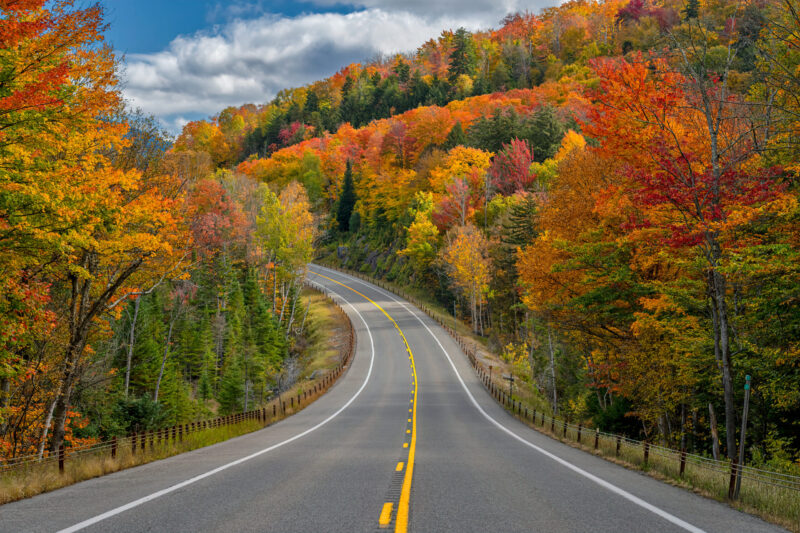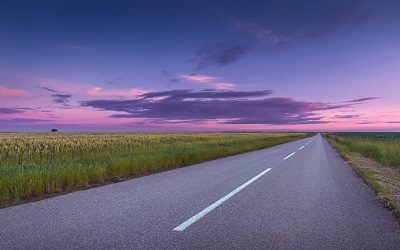As the autumn season arrives, the dramatic display of colorful leaves is a great reason to hit the open road and do some leaf peeping. In the words of Albert Camus, “Autumn is a second spring when every leaf is a flower.” Whether you opt for a leisurely drive around town, take a day trip somewhere close by or head out on an epic road trip, gazing at spectacular fall foliage is a feel-good activity that’s free to enjoy. What more can you ask for?
Why Do Leaves Change Color?
Trees, vines, bushes and shrubs dress themselves up in a dazzling rainbow of colors for the fall – but have you ever wondered how they make this magic happen? As summer fades into fall, the days get shorter, meaning there are fewer hours of sunlight. The lack of sunlight and increasingly cooler nights is a signal to the leaves to stop producing chlorophyll, which is the pigment that gives leaves their green coloring the rest of the year. As the chlorophyll breaks down, other pigments appear, creating the beautiful ranges of reds, purples, yellows and oranges that you see in the autumn.
When Will Leaves Start to Change?
Officially, autumn begins on September 22nd, but you won’t really know it by looking at the trees in most parts of the country. Although the transition away from green varies slightly from year to year and depends on how long it takes the warm summer temperatures to fade, trees in the most northern parts of the country start to get a touch of fall color by mid-September.
The transition to color slowly progresses into the middle and lower regions of the country, as trees transform in the following weeks. As you might expect, the warmer regions of the country see the transition later in the year, with the first changes arriving in early-to-mid October.
The first signs of fall color will always be detected in the most northern parts of the country – and also in the most elevated regions. For example, in Great Smoky Mountains National Park, colors change as early as the first or second week of September where the elevation is over 4,000 feet. The forested areas below this level remain mostly green until about mid-October.
The Look of Autumn Where You Are
While viewing the fall foliage is a popular annual ritual for anyone in the New England area, those living in places like Arizona or southern California aren’t used to experiencing a dramatic change in seasons. How flashy the local fall foliage will be – or not – depends on the kinds of trees that grow in your area.

If you’re in a climate that supports large swathes of evergreen trees, you’ll have to really be on the lookout for colorful trees in the autumn. Evergreen trees are just what they sound like – they stay green all year round. When seeking out fall foliage spots, the most dramatic scenery will have little to no growth of evergreen trees. In the cooler climates, pine, spruce, cedar and fir trees don’t change color in the fall; they maintain their sturdy, deep green needles or thick leaves throughout the year. Palm trees, found in the warmer climates, will also keep their tropical, feathery green fronds throughout the fall, although they do shed leaves regularly.
Statistically, the amount of autumn scenery you’ll encounter is also determined by the density of trees in your state. The most popular fall foliage spots are:
- Maine
- New Hampshire
- West Virginia
- Vermont
The territory of these states boast between 78 to 90% forest coverage. On the other hand, North Dakota, South Dakota and Nebraska rank at the very bottom of the list, with only 1 to 2% forest coverage. That doesn’t mean these states won’t have fall colors in certain spots, but if you’re driving through, it’ll be harder to spot any dramatic foliage.
Autumn Colors by Tree
Another way to predict the autumn display in your area is to know the colors produced by the trees. If you can identify the trees, use the chart below to find out what colors you can expect in the fall. The shade and intensity of color will depend on where you are in the country and the weather that occurs during the fall season.

Take a Fall Foliage Road Trip
Don’t live near a fall foliage hot spot? Time to plan a road trip!
For a leisurely day trip, choose the most scenic route through the countryside. At a slower speed you’ll be able to take in the most trees. Check the map for parks or viewpoints along the way. You can stop for a lunch break or just to take pictures.
If you’re planning a longer trip of a few days or few weeks, perhaps in your RV, then choose your route according to the peak viewing time of the places you want to see most. For example, to see the trees at their most mesmerizing moment along the east coast, drive from north to south. Fall colors appear first in the more northern regions. Just remember to call or check the state park website in advance to confirm opening hours and camping guidelines.
Teaching a teen to drive this fall? Get expert tips and advice developed by The Hartford’s corporate gerontologists. Download your free PDF guide today.
When Should I Expect Peak Leaf Viewing?
The most dramatic moment of the fall colors can come and go within a week or 10 days. And the timing all depends on which part of the country you’re in. In the last decade, peak viewing time has been around October 5th through the 11th. This year experts predict the height of the fall colors to arrive a little later in most of the country, around mid-October.
In the Pacific Northwest, Washington and Oregon will be at their peak viewing point from about October 12th through the 19th. The middle part of the country runs on a later schedule. Peak viewing in Tennessee (including the popular Great Smoky Mountain National Park) and Kentucky is in the last few days of October through the first week of November. Similarly, Hill Country in central Texas and other warmer states display peak viewing time in the last week of October and lasting through the first and second weeks of November.

The Farmer’s Almanac has been giving out advice on the ways of Mother Nature since 1792. The online version features an annually updated list of the dates for peak fall foliage by state.
Popular Leaf-Peeping Sites Across the U.S.
Ready to go check out some gorgeous autumn colors but not sure where to start? Here’s a round-up of some beloved leaf viewing spots from around the country. But remember that weather plays an important role in the timing of the color transition. Before you head out, confirm the peak viewing date range with the official state tourism website or national park website. Most states even have a fall foliage hotline. Call to get the most up-to-date information on the local trees.
- Great Smoky Mountain National Park, Tennessee
- Ozark National Forest, Arkansas
- Stowe, Vermont
- Bar Harbor, Maine
- Shenandoah Valley, Virginia
- Eastern Shore, Maryland
- Poconos Mountains, Pennsylvania
- The Enchanted Circle, New Mexico
- Brown County State Park, Indiana
- Hill Country, Texas
Of course, this list is just a sampling of the many wonderful fall foliage places that exist across the country.
Enjoy the View—Safely!
Fall is a special time of year, full of colors and the promise of change. While you’re on the road with your loved ones taking in the scenery, be sure to always practice safe driving habits, such as keeping your eyes on the road and pulling over when necessary to take in the view. Remember: distracted driving is more than just texting.







Helpful. Usually go to laurel springs nc above Wilkesboro nc and ride on the blue ridge parkway! Spent lot of time there. Dad and my grand parents had land there
Stilling the family.